#the king of fighters dream match 1999
Explore tagged Tumblr posts
Video
youtube
Console Fighting Games of 1999 - Compilation Part 5
Part 5 of 5 of a compilation of console fighting games released in 1999, this compilation includes The King of Fighters Dream Match 1999, Toshinden 4, Transformers Beast Wars Transmetals, Warpath Jurassic Park, WCW Nitro, WCW-nWo Thunder, Wu Tang Shaolin Style and Xena Warrior Princess The Talisman of Fate, time stamps for each game below.
1. Intro 00:00
2. The King of Fighters Dream Match 1999 00:10
3. Toshinden 4 13:30
4. Transformers Beast Wars Transmetals 23:11
5. Warpath Jurassic Park 27:00
6. WCW Nitro 36:32
7. WCW-nWo Thunder 46:01
8. Wu Tang Shaolin Style 59:34
9. Xena Warrior Princess The Talisman of Fate 01:06:38
10. Honourable Mentions 01:12:57
11. Outro 01:13:37
Twitter (Gaming & AI Art)
https://twitter.com/zero2zedGaming
Instagram (AI Art)
https://www.instagram.com/random_art_ai/
For more fighting game videos check out the playlists below
Console Fighting Games of 1993
https://www.youtube.com/playlist?list=PLFJOZYl1h1CFcKSo9Eglrv2NFDHAqNDRi
Console Fighting Games of 1994
https://www.youtube.com/playlist?list=PLFJOZYl1h1CF-R5w4NujQcYo8cCcOMHYv
Console Fighting Games of 1995
https://www.youtube.com/playlist?list=PLFJOZYl1h1CEUiZn8FlwHoMcwoOzUqchX
Console Fighting Games of 1996
https://www.youtube.com/playlist?list=PLFJOZYl1h1CF0j9K_v7UqS3dxjwh6XIIM
Console Fighting Games of 1997
https://www.youtube.com/playlist?list=PLFJOZYl1h1CFm1r27Q5PvbO_4CjYYsj4-
Console Fighting Games of 1998
https://www.youtube.com/playlist?list=PLFJOZYl1h1CHG7kROLoO-HAXmmzib8cd4
Console Fighting Games of 1999
https://www.youtube.com/playlist?list=PLFJOZYl1h1CH1CPUcsBRyu5VpFnhqj4Kv
#youtube#the king of fighters dream match 1999#toshinden 4#warpath jurassic park#wcw nitro#wcw nwo thunder#wu tang shaolin style#transformers beast wars transmetals#xena warrior princess the talisman of fate#90s games#90s gaming#fighting games#wrestling#xena warrior princess#jurassic park#toshinden#the king of fighters#transformers
1 note
·
View note
Text
Sega Dreamcast - The King of Fighters 99 Evolution
Title: The King of Fighters 99 Evolution / ザ・キングオブファイターズ'99 エヴォリューション
Developer/Publisher: SNK
Release date: 25 October 2001 (SNK Best Buy)
Catalogue No.: T-3109M (SNK Best Buy)
Genre: 2D Fighting


Funny story. There was a time in my life when I owned a mint copy of this game (I had the Agetec-published American version with code T-44302N) but like an idiot I sold it (-_-) Now I'm graced with a really tatty T-3102M NTSC-J Japanese copy whose previously owner was a right slob. I managed to clean it up a bit, but it still looks used. Probably the only game in my NTSC-J DC collection that does look used. Which is why that is not being featured.
Since my T-3102M original version of this game is in a bad state (the only other game I have in such a terrible condition was Sonic and the Black Knight on Wii) I decided to buy this T-3109M SNK Best Buy re-release. The game is identical to the original bar the front and back artwork, which is quite an improvement, I think. I have to give SNK a big thumbs up for releasing their best collections in normal-looking cases. Normally some companies just use the original artwork surrounded by some new "Cheap Version" logo or they slap a big sticker onto the cover. Not SNK though. They give you a brand-new cover that looks like an original release. That's what we like to see.
Anyway, the game is quite a disappointment after the beautiful Dream Match 1999 release with its 2.5D backgrounds. This game is identical to the original Neo Geo version. While this is no bad thing it does look extremely dated on the Dreamcast. Later KOF games on the Dreamcast seemed to run in a higher resolution than this one making them look that little bit more modern. But it's not all about looks, is it? The King of Fighters '99 Evolution is a good solid fighter that any fan of the series will enjoy. I just wish that SNK took the time to spruce it up a bit like their previous Dreamcast King of Fighters game (Dream Match 1999).

youtube
#sega dreamcast#neo geo#the king of fighters#art of fighting#fatal fury#ikari warriors#psycho soldier#terry bogard#athena asamiya#kim kaphwan#mai shiranui#ryo sakazaki#Youtube
4 notes
·
View notes
Text
Gaming Spotlight #11: Digimon Rumble Arena (2001)
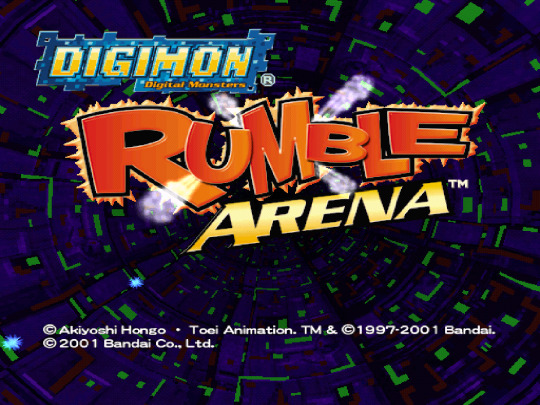
Hello this is Larsa here with another spotlight feature on a game you may have missed from the Playstation era. Stand up to the fight!
Before we get to our featured title let's review some history shall we? Super Smash Bros 64 came out in the year 1999 developed by HAL Laboratory, INC. This revolutionary game was inspired by the dream match concept of SNK Corporation's own popular "King of Fighters" series where a bunch of a existing characters are thrown together to duke it out. Many in the industry took notice as the success of the new Nintendo crossover fighting game which created many fans of a whole new genre, platform fighting games.
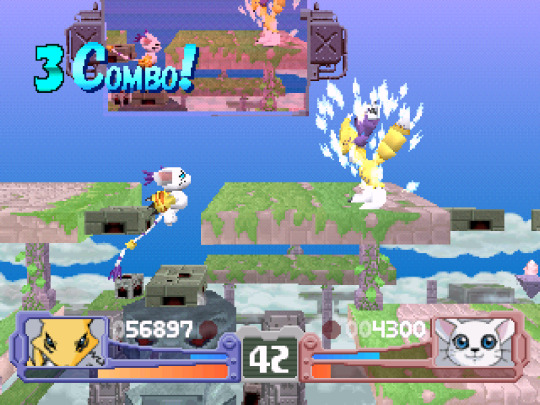
"Digimon Rumble Arena" or "Digimon Tamers: Battle Evolution" as it is known as in Japan would become one of the first early platform fighting games following in the giant shadow of "Super Smash Bros 64" to stand out as a game worth playing. Right away a fighting game based on one of the most popular anime series of the late 90s and early 00s just seems like a perfect pairing. By the time this game was released Digimon had firmly became a massively popular series already having a theatrical movie release worldwide and currently airing its very popular third season titled "Digimon Tamers". Right away the opening would blow the minds of any young Digimon fans at the time because it was essentially a Digimon dream match title starring the Digimon and tamers of the first three seasons slugging it out for digital supremacy.
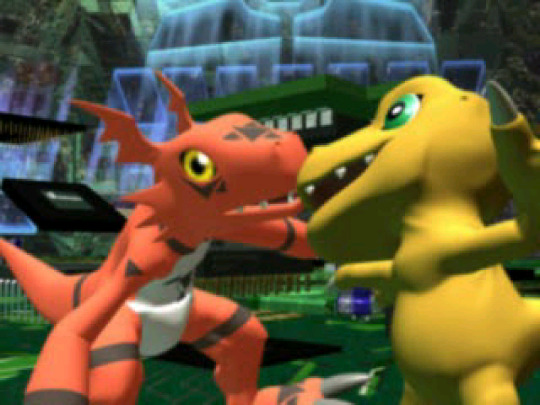
Is Guilmon really stronger than Agumon? How about Gatomon versus Renamon? Or how about a mega level battle of Beelzemon versus Omnimon? These were and still are important questions worth asking for any Digimon fan. And these sorts of playground questions are why this game was created.
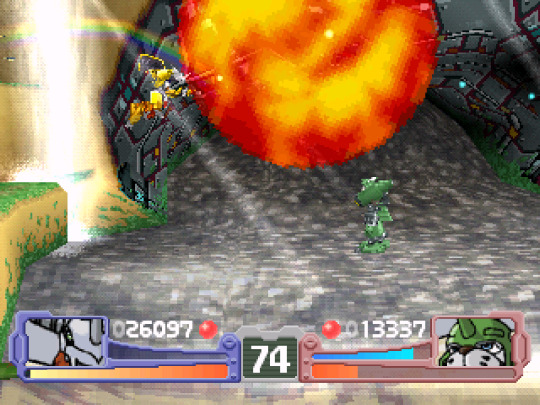
The gameplay features two opposing Digimon battling it out on one of the several different stages in a 2D plane. These stages are typically filled with unique stage hazards and ring out zones with randomly spawning items in the form cards which have a myriad of effects on the battle. These cards mirror the "Digi-Modify" or "Card Slash!" mechanics from the Digimon Tamers series . The roster is filled with Digimon supported by their appropriate tamers from the show with the same familiar voices for each character featuring over 20 playable Digimon. Unlike "Super Smash Bros" this game features a more traditional health bar system and draining your opponent's life bar to zero means victory. Each Digimon has two special moves and a myriad of normal attack strings you would expect in a fighting game. Right away in a way one would expect from this beloved franchise, Rookie level Digimon are capable of transforming into a stronger even more capable form in the middle of battle through Digivolution. Digivolving improves your stats and gives you a completely new different move-set than before meaning you as a player are often switching dynamically between different gameplay experiences. There are few things that feel better than securing a comeback victory with your favorite mascot Digimon because of a well timed Digivolution. Oh and wiping the floor with your opponent using Wargreymon's mighty signature technique, Terra Force.
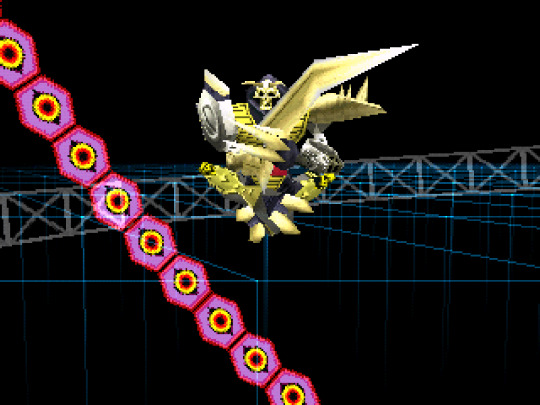
The main modes of the game are arcade mode and versus modes. In the Arcade Mode you take your selected Digimon through an arcade style ladder of bouts plus a few mini-games along the way with the goal of unlocking more characters. That is until you reach the new big bad of the game at the top of the ladder. Reapermon (Also known originally as Gokumon or ゴクモン) is a very difficult opponent to overcome and even now he still manages to give me trouble. I and along with anybody else who has ever played this game know of the horrors of his most powerful technique "Burning Cyclone". He is a cheap old school style boss who will test your skill at the game as one would expect from an older fighting game eating your quarters though in this case you thankfully probably own the game and you have as long as necessary to defeat him. Thankfully if you are struggling you can use some in-game cheat codes to fast unlock some Mega level Digimon along with other goodies to help even the odds. As far as versus modes go you can battle a friend locally or even play the mini-games against them. I spent many sessions having tons of fun fighting friends in this game. For an early platform fighting game the controls and mechanics are quite responsive which makes for amusing competitive bouts.
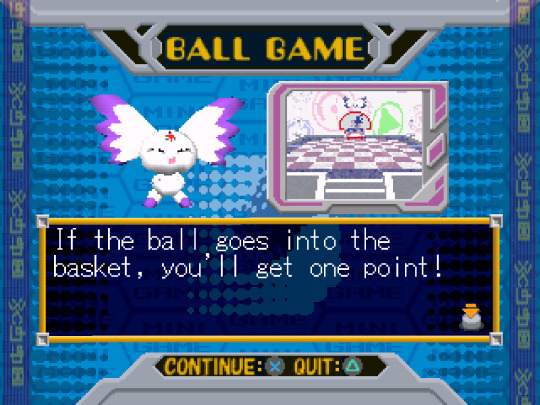
The graphics and soundtrack of the game of the game are very impressive for the platform. The Japanese version of the game features many arrangements of songs from the anime series. However the game does have one big problem: the framerate slowdown is a persistent problem throughout the experience with this game. Unfortunately they are the game's immediate faults but the game has so much excellent fanservice content and a surprisingly responsive solid fighting game underneath that it is easy to forgive the shortcoming. This game is still pretty awesome and loaded with nostalgia for me having grown up with Digimon. This title gets my recommendation for any fans of Digimon to experience especially the Japanese version of the soundtrack if you are ever in need of a quick nostalgia-fueled adrenaline rush.
A gem hidden among the stones, Digimon Rumble Arena is unquestionably stardust.
– Larsa
#retro gaming#gaming#video games#psone#ps1#psx#acquired stardust#playstation#larsa#digimon#digimon rumble arena#gaming spotlights#nostalgia#Digimon Tamers Battle Evolution#platform fighter#fighting games#game spotlights
14 notes
·
View notes
Text
Round One 'Stache Match-ups
Peppino Spaghetti (Pizza Tower) vs Professor Rowan (Pokémon) Geppetto (Pinocchio 1940) vs Tim Lockwood (Cloudy with a Chance of Meatballs)The Lorax (The Lorax) vs William Riker (Star Trek: Next Generation) The President (Pikmin) vs King Dice (Cuphead) Nigel Thornberry (The Wild Thornberrys) vs Kratos (God of War) Filbrick Pines (Gravity Falls) vs Mouse Kaboom (Happy Tree Friends) Tarzan's Dad (Tarzan 1999) vs Drayden (Pokémon) Morshu (Legend of Zelda) vs Magikarp (Pokémon) Luigi (Super Mario) vs Snidely Whiplash (Rocky and Bullwinkle) Dracula (Castlevania) vs Gaepora (Legend of Zelda) Hades (Hades) vs Geralt (The Witcher) Jules Winnfield (Pulp Fiction) vs Walrus Captain (A Hat in Time) Dr. Wily (Megaman) vs Charlie Swan (Twilight) King of All Cosmos (Katamari) vs Hizashi "Present Mic" Yamada (My Hero Academia) Drake (Pokémon) vs Craigor Smiff (Red Stitch Report) Blaine (Pokémon) vs Gimli (The Lord of the Rings)
Eggman (Sonic) vs Lando Calrissian (Star Wars) Archibald Dandy (The Adventures of Captain Wrongel) vs Walter White (Breaking Bad) Mung Daal (Chowder) vs Linebeck III (Legend of Zelda) Kingambit (Pokémon) vs Doc Louis (Punch-Out!!) Major Alex Louis Armstrong (Fullmetal Alchemist) vs Doctor Neo Cortex (Crash Bandicoot) Soichiro Yagami (Death Note) vs Murro Morton (Identity V) Baron Zeppeli (JoJo's Bizarre Adventure Part 1: Phantom Blood) vs J. Jonah Jameson (Marvel) Wulfric (Pokémon) vs Henry Henderson (Spy x Family) Gashu Satou (Your Turn to Die) vs Stanley Hudson (The Office) Alolan Golem (Pokémon) vs Landorus (Pokémon) King Harkinian (Legend of Zelda) vs Thundurus (Pokémon) Gustavo (Pizza Tower) vs Tornadus (Pokémon) Broque Monsieur (Mario & Luigi) vs Cadmus Ebcott (Red Stitch Report) Rhys Strongfork (Borderlands) vs Agustín Madrigal (Encanto) Bob Belcher (Bob's Burgers) vs Soseki Natsume (The Great Ace Attorney Chronicles) Oscar (Duolingo) vs Professor Turo (Pokémon)
Soda Popinski (Punch-Out!!) vs Mario (Super Mario) Cliff Clavin (Cheers) vs King River Butterfly (Star vs the Forces of Evil) Stoutland (Pokémon) vs Grandpa Harley (Homestuck) Von Kaiser (Punch-Out!!) vs The Captain (BBC Ghosts) Mustache Girl (A Hat in Time) vs Tobias Fünke (Arrested Development) Chat Noir (Miraculous Ladybug) vs Randy Marsh (South Park) Wario (Super Mario) vs Gandalf (The Lord of the Rings) Kevin Ayuso (Identity V) vs Mr Pickels (Happy Tree Friends) Inigo Montoya (The Princess Bride) vs Minimus Ambus (Transformers: More Than Meets The Eye) Kricketune (Pokémon) vs Eldstar (Paper Mario) Jane Crocker (clever disguise) (Homestuck) vs Advisor Mung (Hypnagogia 無限の夢 Boundless Dreams) Saguaro (Pokémon) vs Revolver Ocelot (Metal Gear Solid) GOING TO REMATCH Waluigi (Super Mario) vs Vincenzo Santorini (Atlantis: The Lost Empire) Mr. Rime (Pokémon) vs Raikou (Pokémon) Sportacus (Lazy Town) vs Ron Swanson (Parks and Recreation) Steven Magnet (My Little Pony: Friendship is Magic) vs Sir Humphrey Bone (BBC Ghosts) Sea Hawk (She-Ra and the Princesses of Power) vs Duster (Mother 3) Varrick (The Legend of Korra) vs King Bradley (Fullmetal Alchemist) Omni-Man (Invincible) vs Brigadier Alistair Gordon Lethbridge-Stewart (Doctor Who) William Murderface Murderface Murderface (Metalocalypse) vs Lolorito Nanarito (Final Fantasy XIV) Mumbo Jumbo (Hermitcraft) vs Probopass (Pokémon) The Toy Soldier (The Mechanisms) vs Chancellor Cole (Legend of Zelda) Alakazam (Pokémon) vs Entei (Pokémon) Thom Merrilin (The Wheel of Time) vs James Gordon (DC Comics) Gomez Addams (The Addams Family) vs Solid Snake (Metal Gear Solid) GOING TO REMATCH Asgore Dreemurr (Undertale) vs Taryon Gary Darrington (Critical Role) Julius Pringle (Pringles) vs Netero (Hunter x Hunter) Dudley (Street Fighter) vs Barret Wallace (Final Fantasy VII) BJ Hunnicutt (M*A*S*H) vs Daruk (Legend of Zelda) Mabosstiff (Pokémon) vs Vito Corleone (The Godfather) Cervantes (Fire Emblem) vs Don Paolo (Professor Layton) Gordan Freeman (Half-Life) vs Zangief (Street Fighter)
25 notes
·
View notes
Text
🕹🎮👑🔥
The King of Fighters: Dream Match 1999
『ザ・キング・オブ・ファイターズ DREAM MATCH 1999』
(ザ・キング・オブ・ファイターズ ドリームマッチナインティーンナインティナイン)
1999年6月24日発売
ドリームキャスト
SNK
Dream Match 1999
#THEKINGOFFIGHTERSDreamMatch1999 #DreamMatch1999 #THEKINGOFFIGHTERS #ザキングオブファイターズドリームマッチナインティーンナインティナイン #ザキングオブファイターズ #SNK #エスエヌケイ #kof #kofDreamMatch1999 #fgc #fightinggames #fightinggamescommunity #jogosdeluta #dreamcast #ドリームキャスト#セガ #SEGA #戦型格闘ゲーム #対戦型格闘ゲーム #格闘ゲーム #格ゲー #株式会社エスエヌケイ #戦型格闘ゲーム #エクストリームイーストエフジーシー #extremeeastfgc
0 notes
Text

Japanese cover artwork for the SNK Dreamcast title from 1999:
The King of Fighters: Dream Match 1999 / ザ・キング・オブ・ファイターズ ドリーム・マッチ 1999
The Dreamcast rename of The King of Fighters '98: Dream Match Never Ends was an odd decision not least because it caused quite a bit of confusion when the proper The King of Fighters '99 got a release on the system. Link is to our video from the other night.
Follow Randomised Gaming on Tumblr, for video game, art, reviews, features, videos and more. You can also find us on twitter and subscribe to us on YouTube for even more gaming content!
30 notes
·
View notes
Photo

King Of Fighters: Dream Match 1999 game flyer (chirashi) for the Sega Dreamcast
Ah, the Dreamcast. This game supported the link cable between the Dreamcast and the Neo Geo Pocket Color to interact with King Of Fighters R2 on the handheld console.
#King Of Fighters#KOF#Dream Match 1999#Sega#Dreamcast#retrogaming#セガドリームキャスト#キングオブファイターズ#レトロゲーム#ネオジオ#ポケットカラー
31 notes
·
View notes
Video
tumblr
[ SNK DC THE KING OF FIGHTERS DREAM MATCH 1999 CM ]
88 notes
·
View notes
Photo

Street Fighter EX - Um spin-off amado por uns, odiado por outros
Street Fighter EX(1996) é uma série de games de luta, que embora tenha a Capcom como publisher, não é parte do cânone oficial de Street Fighter, ou seja, é apenas um Dream Match, termo muito usado entre jogadores de The King of Fighters para descrever games não canônicos, isto é, que não seguem a linha cronológica da série. Quando o game chegou ao PSX em 1997, foi renomeado como Street Fighter EX Plus α(Alpha), adicionando personagens novos, como Dhalsim, Sakura Kasugano, Akuma, Garuda e M. Bison. A série teve continuações como por exemplo Street Fighter EX2 Plus(1999) e Street Fighter EX 3, lançado ao PS2 em 2000. Mas por que a série é tão controversa?! A fanbase é muito dividida, tem pessoas que gostam, outras que odeiam. O gameplay permite fazer Triple Cancels, o que era uma novidade para a época em que foi lançado. Em resumo, Street Fighter EX não foi necessariamente ruim, apenas se desviou das raízes clássicas de Street Fighter ao tentar ir pelo mesmo caminho de Tekken, o fenômeno da Namco que estava fazendo muito sucesso na época do primeiro PlayStation.
3 notes
·
View notes
Video
youtube
Console Fighting Games of 1999 - The King of Fighters Dream Match 1999
This is not the 1999 entry in the SNK-developed King of Fighters series of fighting games, rather it is a special release on the Dreamcast of King of Fighters 98. This version of KOF98 was released in Japan, Brazil and the US in 1999.
1. Intro 00:00
2. Games Intro 00:10
3. Gameplay 02:59
4. Outro 13:32
Twitter (Gaming & AI Art)
https://twitter.com/zero2zedGaming
Instagram (AI Art)
https://www.instagram.com/random_art_ai/
For more fighting game videos check out the playlists below
Console Fighting Games of 1993
https://www.youtube.com/playlist?list=PLFJOZYl1h1CFcKSo9Eglrv2NFDHAqNDRi
Console Fighting Games of 1994
https://www.youtube.com/playlist?list=PLFJOZYl1h1CF-R5w4NujQcYo8cCcOMHYv
Console Fighting Games of 1995
https://www.youtube.com/playlist?list=PLFJOZYl1h1CEUiZn8FlwHoMcwoOzUqchX
Console Fighting Games of 1996
https://www.youtube.com/playlist?list=PLFJOZYl1h1CF0j9K_v7UqS3dxjwh6XIIM
Console Fighting Games of 1997
https://www.youtube.com/playlist?list=PLFJOZYl1h1CFm1r27Q5PvbO_4CjYYsj4-
Console Fighting Games of 1998
https://www.youtube.com/playlist?list=PLFJOZYl1h1CHG7kROLoO-HAXmmzib8cd4
Console Fighting Games of 1999
https://www.youtube.com/playlist?list=PLFJOZYl1h1CH1CPUcsBRyu5VpFnhqj4Kv
#youtube#kof#king of fighters#the king of fighters#90s games#90s gaming#fighting games#video games#snk#dreamcast#kof98#the king of fighters dream match 1999
0 notes
Text
Sega Dreamcast - The King of Fighters Dream Match 1999
Title: The King of Fighters Dream Match 1999 / ザ・キング・オブ・ファイターズ ドリーム・マッチ 1999
Developer/Publisher: SNK
Release date: 24 June 1999
Catalogue No.: T-3101M
Genre: 2D Fighting


The King of Fighters Dream Match 1999 (based on the King of Fighters 98) was the first Dreamcast KOF game and is considered by many as being the best King of Fighters game around. It’s also the first of two Dreamcast KOF games made by the old SNK. KOF 2000, 2001, and 2002 all came from the new Playmore / SNK. This Dreamcast version however is vastly superior to the Neo Geo original although those hard-core Neo Geo fanboys may disagree. It plays identically to the Neo Geo version in every respect plus is filled with bonuses such as the Neo Geo Pocket data transfer option. Yes, it was possible to transfer data between the Dreamcast and the Neo Geo Pocket KOF game to enable you to open up new options in each game. This was quite an exciting feature but sadly died. I know that Cool Cool Toon offers such an option as well as one or two others but that was it. Anyway, back to KOF’99 Dream Match. In stills, the Dreamcast version looks identical to the Neo Geo which is no great feat. Only when it starts to move do you realize that it’s actually in 3D!! SNK has done a wonderful job of recreating the original backgrounds in 3D for this Dreamcast version. They look so good and in no way interfere with the playability of the game. It’s just a shame that this is the only KOF game done in this way. I take it that SNK just didn’t have the money or time to recreate this effect for KOF 1999 which is a great shame really. If you’ve got a Dreamcast and into fighting games, then make sure you pick this one up. It’s far more fun than Capcom VS SNK 1.


youtube
#sega dreamcast#neo geo#the king of fighters#art of fighting#fatal fury#ikari warriors#psycho soldier#terry bogard#athena asamiya#kim kaphwan#mai shiranui#ryo sakazaki#kof 98#Youtube
3 notes
·
View notes
Text
REVIEW: SNK Vs. Capcom: The Match Of The Millennium (1999)
When it comes to 2D fighting games during the early/mid 90’s, there’s two names that absolutely dominated the scene with their releases and became household names;
SNK and Capcom.
To this day they remain some of the most well respected and most loved games companies in the fighting game genre, so the prospect of a crossover between the two companies back then was certainly a tantalising thought.
In November of 1999, we got just that in the form of SNK Vs. Capcom: The Match Of The Millennium for the Neo Geo Pocket Color system.
While this wasn’t the first time we’d see the brands clash in a single game (that award goes to SNK Vs. Capcom: Card Fighters Clash, released earlier that year), it was the first time they would meet in the setting of a tradition versus fighting game.
The game was a critical success, and was followed up with entries in the genre that many consider to be the best fighting games ever made.
So, with the bar set so high with this historic title, it finally sees a re-release on the Nintendo Switch almost 22 years later as part of Nintendo’s Neo Geo Pocket Color Selection series, alongside games such as SNK Gals’ Fighters, The King Of Fighters R-2 and Fatal Fury: First Contact.
So, does it still hold up all these years later?
Let’s find out…
Gameplay
First of all, there’s a number of different ways in which players can play through the tournament mode (and regular versus mode); you can either go 1-on-1, fight a 2-on-2 battle as a tag team, or as a team of three in an elimination match. This variety of battle styles appeals to players who may be used to fighting in different forms.
Want to play this like a King Of Fighters game? Go ahead!
How about like the Marvel Vs Capcom titles? Play as a tag-team to your heart’s content, my friend!
For a game that utilises just two attack buttons, there’s a surprising amount of depth to how special moves are executed as well. Instead of relying on the four-button approach that SNK based their games on or the usual six-button layout in many of the Capcom fighting games, SNK Vs. Capcom: The Match Of The Millennium’s control scheme actually focuses on how long the A and B buttons are pressed.
The longer a button is pressed, the higher the amount of damage it causes (but takes a hit to how quick it is), mimicking the LP/MP/HP and LK/MK/HK button functions in games such as Street Fighter II and Darkstalkers.
It’s a simple system that works wonders, and makes the amalgamation of each games franchise’s special moves work together seamlessly.
The game also boasts three different “power gauge” command styles to choose from too;
AVERAGE - This is similar to the traditional super gauge in the Street Fighter games, where once the gauge is filled up, more powerful versions of normal attacks can be pulled off.
COUNTER - This is a more defensive approach that allows counterblows while evading enemy attacks. It also has an exclusive function in the form of “critical hits”, which do greater damage if they successfully hit an opponent.
RUSH - This one only fills up when chain combos are successfully executed, and although this gauge nerfs your normal attack damage, super moves can be done at any time (as long as there’s enough juice in the tank, so to speak).
So no matter which side of the fighting game coin you land on, there’s definitely a playstyle in SNK Vs. Capcom: The Match Of The Millennium that will suit you perfectly.
In the original release, if players wanted to play against each other, a link cable and another console were required, making it something of a inconvenience. Thankfully this new Switch port has 2-player versus available straight away by using the two joycons.
Story
The game’s main storyline centres around a not-so-subtly named fighting tournament known as the “Battle Tournament of Evil”, which promises the victor the title of “World’s Mightiest” and a ridiculously high amount of prize money.
The benefactors and organisers of said tournament? None other than Fatal Fury’s Geese Howard and Street Fighter II’s M. Bison!
This newly formed alliance of nefarious (and powerful) psychopaths has an ulterior motive with the tournament, and intend to create an “immortal military” whose first wave of elite soldiers are to be the captured contestants.
The character stories vary slightly depending on whether an SNK fighter or a Capcom fighter is chosen, and the game’s ending depends on the outcome of a specific match during the tournament where a player faces off against their rival.
Putting together the two “Big Bads” that are synonymous with their respective franchises is a great move and the fact that players can get a “bad ending” through poor performance in just a single match ups the ante somewhat as well.
Roster
SNK Vs. Capcom: The Match Of The Millennium’s roster is comprised of 26 different fighters (18 of which are immediately playable, with a further 8 that are unlockable) from across the various SNK and Capcom franchises;
From the King Of Fighters, Fatal Fury and Art Of Fighting games, we get Kyo, Terry Bogard, Iori, Ryo Sakazaki, Mai and Leona.
From Psycho Soldier, we get Athena.
From the Samurai Shodown series, we get Haohmaru and Nakoruru
From Street Fighter II, we get Ryu, Ken, Chun-Li, Guile and Zangief.
From the Street Fighter Alpha series, we get Sakura and Dan
From Darkstalkers, we get Morrigan and Felicia.
The unlockable fighters in the game are from a good mix of the various games series, and there are 4 to unlock for each side.
It’s an impressive roster for a game that was released on a platform like this, and does a great job of bringing together the more familiar faces of Capcom’s games with some perhaps lesser known fighters from the SNK side.
Graphics
SNK Vs. Capcom: The Match Of The Millennium’s stylised graphics are one of the most immediate things players will notice about the game.
The character sprites are more cartoonish versions of each fighter’s normal likeness and all strictly adhere to a 3-colour palette. Considering the history of alternate looks for 2D fighting game characters being simple colour swaps, this simplistic look works really well for the most part (well, Zangief might be the only exception here…).
Seeing the fighters in motion is also a joyous thing too, as the movement during fights is fluid and animated to a brilliant degree. Even the animations when characters are idle feel charming in this game!
A large problem with fighting games on handheld systems during this era was that they all too often felt like an attempt at creating a scaled down version of the bigger, more technically advanced games to fit the lower specs of the systems, ultimately resulting in a crappy version of the game.
Games such as this, along with many other titles in the Neo Geo Pocket Color library, always felt like they were made from the ground up to fit the system, so they not only played well, but they also looked very unique in a really positive way.
SNK Vs Capcom: The Match Of The Millennium is arguably the best of the bunch, and it deserves praise for it.
As is par for the course with retro fighting game re-releases on modern hardware, there’s also some extra display options to help things feel like the real deal, but with this (and the other NGPC releases on the Switch), there’s the option to view the game in a mocked up fashion on a number of different Neo Geo Pocket Color models. It’s a nice touch that effectively shows the amount of care being put into this port.
Stages
The stages in the game are essentially a megamix of different locations from several SNK and Capcom games, ranging from the helicopter wreckage in The King Of Fighters ‘94’s Brazilian jungle, the Great Wall Of China from Street Fighter Alpha: Warriors’ Dreams and the crashing rocky waves of Japan from Samurai Shodown to the cloudy Japanese castle of Ryu’s Street Fighter II stage, Morrigan’s spooky Scottish Darkstalkers cave/lair combo and the moving train carriages that pass by Mount Rushmore (over and over again) from Fatal Fury 2.
There’s plenty of references for longtime fans of these games to spot, and they have been recreated perfectly to fit in with the game’s visual style.
I mean, sure, some of the characters in the backgrounds do look a little murky and lack detail in places, but when you consider that the screen on a Neo Geo Pocket Color was a smaller, low resolution affair, it can be ignored for the most part!
Replayability
SNK Vs. Capcom: The Match Of The Millennium’s gameplay experience is essentially split into two halves.
One one side, you have the regular versus game modes and a story mode to fight through, as one would expect from pretty much every fighting game. On the other side is the unlocking all of the hidden characters and beating a plethora of minigames to earn new special moves.
This is where the game’s replay value truly shines through, and its nice to see that it’s all present in its original form on the Switch port.
These extra games are known as “Olympic Mode”, and is divided up into separate SNK and Capcom sections. While both sections do share some of the same minigames, such as the 100-round survival match, Time Attack and the “whoever gets connects with the first hit, wins!” mode, there are also a couple of games that are unique to each brand.
On the SNK side, managed by Samurai Shodown’s Rimiruru, we get “Targets” - a shooting game that sees players assume the role of Marcus from the Metal Slug franchise as he shoots down as many aliens as possible. We also get “Blade Arts” - where players take on the role of Samurai Shodown’s Jubei as he slices through as many straw dummies as possible before a timer expires.
On the Capcom side, managed by Street Fighter Alpha 3’s Karin, we get “Ghost Trick”; which sees Ghosts ‘n Goblins’ Arthur having to jump across platforms to collect treasures on each side of the screen while avoiding a pesky Firebrand that pops up between them. The other challenge - “Cat Walk” - is a Dance Dance Revolution-style minigame that sees players have to quickly input buttons as they are announced so that Felicia can dance along.
These extra modes are pretty challenging, and undeniably make the game feel so much more complete, while also showing some much deserved appreciation for other iconic games in both companies’ back catalogs.
Final thoughts & overall score
SNK Vs. Capcom: The Match Of The Millennium is fondly remembered by many as one of the best handheld fighting games ever released, and the Switch port further cements that notion, bringing the series into the modern era.
The visual style of the game still oozes charm, the gameplay system still feels immensely satisfying and the wealth of extra playable content that is packed into it puts many of the more well known titles of the era to shame.
With the features of the Nintendo Switch implemented, the small handful of nagging issues that came with the game’s original release are now completely fixed, making this not only a cool item of interest for fans of either SNK or Capcom, but an absolute essential for any fighting game fan.
For the purposes of this review, a review copy was provided by Renaissance PR on behalf of SNK.
Do you agree with our review of the SNK Vs. Capcom: The Match Of The Millennium?
Let us know in the comments section below!
#Review#Capcom#2021#Nintendo Switch#Neo Geo Pocket Colour#SNK Vs. Capcom: The Match Of The Millennium#1999
0 notes
Text
Sean Castle Looks At The Best Overseas-Born Australian Boxers An Examination of Aussie Joe Bugner
Sean Castle Looks At The Best Overseas-Born Australian Boxers An Examination of “Aussie” Joe Bugner

The Australian boxing scene has been spoilt in recent history with the level of top-class fighters who have left their homeland and decided to ply their trade down under. In the past twenty years we have had two of the greatest fighters of their generation in undisputed world champions Kostya Tszyu (Russia- Junior Welterweight) and Vic Darchinyan (Armenia- Super Flyweight) adopt Australia and make their life here. A search through the record books shows a long and exhaustive list that also includes the class of world champions Johnny Famechon (France) and more recently Lovemore Ndou (South Africa) and Garry St. Clair (Guyana).
When examining such a topic it is important to look closely at the career and the contribution to their sport that each individual has made. Therefore it is entirely appropriate to commence this series with Former British Empire (Commonwealth) and European Heavyweight Champion Joe Bugner and rightfully recognise his position in this unique part in Australia’s rich boxing history.
Born József Kreul Bugner in Hungary in 1950, Bugner holds triple nationality and citizenship, holding passports with the United Kingdom, Australia and his native homeland of Hungary. To get a clear understanding of Bugner’s life it is necessary to understand the environment of Eastern Europe in the period following World War II. This section of the world was very unstable politically. With the advent of the Cold War, Hungary, along with a long list of Eastern European nations, fell to Communist Soviet (USSR) forces in 1956. This was the catalyst for the Bugner family fleeing to safety and seeking refuge in England.

Bugner’s professional career is remarkable in that it spans across an incredible four decades, commencing in England in 1967 and finally drawing to a close in Australia 32 years later in 1999. Bugner competed in an amazing 83 heavyweight contests, winning 69 (43 KOs). There was no indication that such longevity was on the cards when Bugner lost his first professional fight, courtesy of a 3rd round stoppage against mediocre Englishman Paul Brown. Brown only claimed two victories in a thirteen fight professional career, one being Bugner. For the sake of fairness it is only right to point out that Bugner twice avenged this early defeat by knocking out Brown in both rematches.
Following his knockout in his debut fight, Bugner had to make a choice on what path to take. Respond and continue with his dream of becoming a professional fighter or take up a trade position in industrial England. And respond he did. Demonstrating a major difference in approach to the often pampered professionals of the modern era, Bugner stepped into the ring an astonishing 33 times between 1968-70, for 32 victories and a narrow points decision loss. The defining fight in his career came early in 1971 when Bugner took on the beloved English icon Henry Cooper for the British Empire (Commonwealth) and European titles.
Cooper, who became famous for his 1963 bout with the legendary Cassius Clay (later Muhammad Ali) where he had Clay in serious trouble, sprawled all over the canvas towards the end of Round 4. Legend has it that Clay only survived when trainer Angelo Dundee cut Clay’s glove between rounds giving the American valuable time to recover and stop Cooper on cuts in the fifth. In a fiercely contested title fight that went the full scheduled 15 rounds, Bugner was awarded a narrow and highly disputed points victory, sending Cooper into retirement. Following this victory, Bugner would feel the full brunt of English displeasure from here on, with many fight fans actively turning against the Hungarian-born fighter and his popularity at an all-time low.
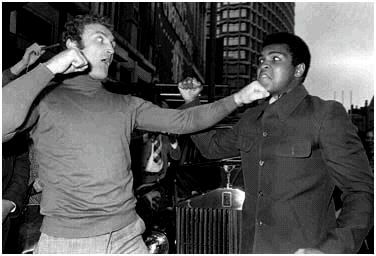
When assessing Bugner’s standing in boxing it is important to have a sound knowledge of the history of the sport. Unlike today, where there are many soft belts given away and too many sanctioning bodies to count, the 1970s, when Bugner was at his best, basically had only the traditional WBA and the more recent breakaway WBC sanctioning world title fights. Often regarded as the golden era of heavyweight boxing with champions of the ilk of three-time world undisputed world champion Muhammad Ali, “Smokin” Joe Frazier and the fearsome George Foreman reigning at various times, easy fights were often hard to find. Contrast this with the poor state of the heavyweight division today where quality contests and interest are at an all-time low. Bugner outlined his frustration at the current state of sanctioning belts to Sean Castle saying “that many of the fighters today with world title belts would not even have been in the Top 10 in the 1960s through to the 1980s. Fighters such as Bugner lament the fact that had they been born a generation late, the titles and the riches that go with them would have been there for the taking.
Bugner, who spent the best part of the 1970’s ranked in the Top 10, has a record that shows that he twice went the distance with Ali and also once with Frazier, getting up off the canvas in the 10th round against Smokin’ Joe to lose a tight decision. Bugner shared with Sean Castle that it incredibly took until his 59th professional fight for him to finally get his shot at the world championship. And the fight was against the greatest of all-time, Muhammad Ali. Coming up against Ali in Kuala Lumpar, Malaysia in 1975, Bugner showed dogged tenacity to push the fighter widely recognised as the greatest of all-time to the full 15 rounds in a bout where Ali collected a then record purse of $2 million dollars. Bugner told Sean Castle that the conditions and environment of the fight meant that he had to arrive at the open air stadium in a bullet proof van as there was a credible assassination threat should Bugner defeat Ali, a Muslim, in an Islamic nation.
The period after the loss to Ali marked the decline in Bugner’s career as a legitimate threat to the world title. A lack of top quality opponents and motivation led to a series of retirements and sporadic comebacks throughout the 1980’s and 1990’s for the fighter dubbed by Ali as the best white fighter in the world. Bugner commented to Sean Castle that he relocated to Australia in 1986 for a new life and decided to give the fight game one final shot, adopting the moniker “Aussie Joe”, Bugner again set out on a journey with the hope of one last shot at glory. Beginning his “Aussie” career by defeating former WBA Heavyweight Champion Greg Page over 10 rounds, Bugner returned to his former home of England in 1987 to take on multiple Mike Tyson whipping boy and future WBC Champion Frank Bruno. This stoppage loss to Bruno at Tottenham Hotspur’s White Hart Lane in front of a large Bruno crowd again sent “Aussie Joe” into another retirement.
It was during the next period out of the ring that Bugner branched out into various other walks of life including acting in a variety of movies for Director Bud Spence, coupled with some other high-risk ventures such as the vineyard he bought and operated in Queensland. Its failure and the mounting debts that accompanied it and also inspired by George Foreman regaining the world heavyweight championship at age 45, led Bugner back into the ring in 1995, 8 years and 11 months since the Bruno fight. He shared with SeanCastle his belief if King George could do it, then so might he.
Highlighting his obvious international class and the lack of depth and quality in the Australian fight game, Bugner was able to capture the national championship in his return bout against Vince Cervi via a 12 round points decision. 1996 brought the regional Pan-Asian Boxing Association (PABA) title after knocking out big-punching Young Haumono in Canberra. Multiple Australian champions Colin Wilson and “Big” Bob Mirovic were on the receiving end of decision losses in 1998 as Bugner prepared for his match up against former world champion James “Bonecrusher” Smith for the lightly regarded World Boxing Foundation title. Smith’s retirement at the end of Round 1 due to a dislocated shoulder gave “Aussie Joe” a world title belt at the age of 48 before a final victory in 1999 against Levi Billups finally closed the curtain on an astonishing 32 year ring career.
Maybe if Bugner fought at his peak in another era then a genuine world title belt might be rightfully placed in his trophy cabinet. Nevertheless, as Australia pays due respect to its “imported” champions, it is appropriate to recognise the contribution and service of “Aussie” Joe Bugner to this great sport over such an extended period.
*Sean Castle is a trained historian and keen boxing fan. In this story he looks back at the career of “Aussie” Joe Bugner. If there is a topic or issue you would liked covered on his blog, email him at [email protected] – www.sean-castle.com
For more blogs or information keep following Sean Castle:-
https://www.f6s.com/sean-castle
https://www.startus.cc/people/sean_castle
https://seancastle.medium.com
https://www.crunchbase.com/person/sean-castle
https://sean-castle.com
0 notes
Photo
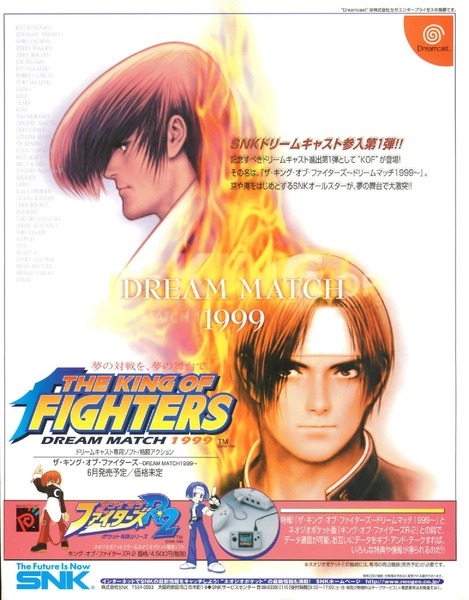
An ad promoting King of Fighters Dream Match 1999, which, confusingly, is actually a port of King of Fighters ‘98. The ad also makes mention of the Dreamcast’s compatibility with the Neo-Geo Pocket Color - items could be unlocked/transferred between KoFDM99 and KoFR2 via cable.
101 notes
·
View notes
Text
The faces of Spanish football: The militarist who terrorized defenses - Salva Ballesta
Politics plays a huge role in football. Sometimes it's subtle, hidden, almost innate.
Other times, it's laid bare, in the open, for everyone to see.
In February 2013, Salva Ballesta was on his way to Vigo - Celta were rumored to have struck a deal with him to become Abel Resino's assistant, and Salva have just reached Madrid when his phone rang.
It was Celta Vigo's president, with some bad news.
Celta's notoriously left-wing base, who greeted him with threats and insults upon his arrival at the Balaídos stadium three years before, had pressured the club to not go forward with the deal.
"I've never spoken about politics, I've always said that I feel Spanish."
Salva Ballesta once said that he was apolitical. And maybe he is right - maybe it isn't political to be nationalistic. Maybe it isn't political to be Spanish.
Maybe it is Spanish of Salva, born to a military family, to say that he would be the first to serve in the Iraq War if conscripted by then prime minister José María Aznar. Or to be a patron of his hometown's military helicopter school. Or even to have your idols be Francoist fighter pilot Joaquín García Morato, Luftwaffe aviator Hans-Ulrich Rudel and Antonio Tejero, leader of the failed "23-F" right-wing coup. Or to say that he wouldn't even consider playing for an autonomous community team.
But is it really Spanish to suggest sending the armed forces into the Basque Country to deal with the ETA? Or, when sent off for Málaga, to shout "¡Que viva España, hijos de puta!" (Long live Spain, sons of bitches!), to Osasuna fans who support Basque independence - something which prompted fans of even bitter rivals Real Sociedad to support Osasuna and display a banner reading "Salva, muérete" (Salva, die) when he visited their Anoeta Stadium? Or to say that "to be anti-madridista makes you a less intelligent person"? Or to say that he had more respect for "dog crap" than for outspoken left-winger and Barcelona defender Oleguer Presas?
Maybe it is - maybe it isn't. Nevetheless, Salva made very few friends for what many, contrary to his claims, perceived to be far-right politics.
But one thing was abundantly clear - whatever his politics, his controversy off the pitch was in stark contrast to his performances on the pitch. For 90 minutes each week, media frenzy was replaced by media appreciation.
To put it simply - he was unstoppable.
It was the 1999-00 season, and Real Madrid were under pressure. Michel Salgado and Iván Helguera arrived to supposedly bolster an embarrassingly leaky defense, and the signings of Steve McManaman and Geremi were overshadowed by that of Nicolas Anelka, the hottest young striker in Europe, who looked set to provide genuine competition for Raúl and Fernando Morientes up front. But a horrific start to the season meant that Real Madrid were at one point relegation contenders. On the 14th matchday, Real Zaragoza had come to the Bernabéu and demolished Real Madrid 5-1 - the biggest away win all season - leaving Real Madrid in 17th place in the league.
Towards the end of the season, Real Madrid appeared to have sorted their defensive problems out at last and had been on an 11-match unbeaten run in the league while progressing to the Champions League semi-finals with victory over holders Manchester United.
But then relegation-threatened Racing Santander came to the Bernabéu. And two strikes from Salva, resulting in a 4-2 win, ended Real Madrid's title hopes for good.
Salva finished the season with 27 goals - winning the Pichichi.
Salva was born in Zaragoza, but rose through Sevilla's youth ranks. His first full season with the club was the 1996-97 season, in which he scored 12 goals but the club was relegated - he stayed on for another season before moving to Racing Santander.
That historic season prompted rumors - big moves to the Premier League or the Serie A were widely touted. However, he resigned an almost certain big-money move for a move to second division Atlético Madrid. Recently relegated, the club desperately wanted - and needed - a return to the elite. And while Atlético marginally failed to reach the promotion places, Salva won his second consecutive Pichichi, scoring 21 goals in the 2000-01 season.
His story thereafter is short of Pichichi's but isn't short of success - a La Liga title with Valencia in the 2001-02 season, 18 goals with Málaga in the 2003-04 season - including a hat-trick in a 5-1 league home crushing of Barcelona, and helping Málaga return to La Liga in 2008.
They are linked to the ultra-right movement of Málaga 1487 - an anti-immigrant group whose name commemorates the year in which the Catholic Kings expelled the Muslims from the city. They have repeatedly physically attacked many members of left-wing ultra groups, especially Sevilla's Biris Norte. They celebrated their 20th anniversary with a Nazi rock concert. They are, unsurprisingly, right-wing ultras.
And they, the Frente Bokerón, chanted his name. He was their unofficial representative - and they made him feel at home.
In the summer of 2007, when Málaga were going through bankruptcy and his high salary was proving to be a deterrent, Salva was faced with a choice - either leave, or stay and reduce his wages. The previous six months, he had chosen to leave by playing for Levante on loan. And he had to choose again.
This time, he chose to stay. His salary of €1.2 million was slashed to almost half (€650,000), and Málaga were promoted that year. After Salva retired in 2010 with Segunda outfit Albacete, it was Málaga - who hadn't forgotten his service and what he'd done for the club - who offered him a position as a youth coach, alongside former teammate Francesc Arnau.
And in the summer of 2013, when he was refused the Celta job, he was appointed as the new manager of Málaga's reserves Atlético Malagueño in the Tercera División. His dream is to manage Málaga one day - the club that made the Zaragoza native feel at home.
One day...
0 notes
Text
2D Niche Fighting Game Studio Examu Suspends Its Business Operations
February 12, 2020 8:56 AM EST
Examu technically isn’t going anywhere as Team Arcana, made of the same people, is still there and will be inheriting Examu’s projects.
Examu announced it will suspend all its operations at the end of February 2020. The studio was founded in 1999 and was first known as Yuki Enterprise, before switching names to Examu in March 2007. The studio developed many niche 2D anime fighters launched this past decade, most notably fighters using other IPs.
All of the studio’s ongoing projects including online support of ongoing games will be transferred to Team Arcana, the studio behind Arcana Heart and made up of Examu staff, so it’s not like they’re disappearing. Team Arcana was founded in 2000 and was owned by Examu.
The announcement on Examu’s official site also mentioned how “we decided to suspend our business for now, but we believe we left our mark in the history of fighting games development”.
Team Arcana is also currently developing Arcana Heart 3 Love Max Six Stars!!!!!! Xtend, a follow-up of Arcana Heart 3 Love Max Six Stars!!!!!! available on Steam.
To cite a few examples, Examu developed Nitroplus Blasterz: Heroines Infinite Duel, available on PS3, PS4, and PC via Steam. This game includes various female main characters from popular visual novels outside of Nitroplus’ works as well, such as Saber from Type-Moon’s Fate/Stay Night.
Examu also developed Aquapazza – Aquaplus Dream Match, on Arcade and PS3. This one has characters from Aquaplus games such as Utawarerumono, Tears to Tiara, and To Heart.
The third Examu developed game we’ll be mentioning is Million Arthur: Arcana Blood, on Arcade, PS4, and Steam. This one uses characters from Square Enix’s Million Arthur franchise, and includes crossover characters such as Riesz from Seiken Densetsu 3 / Trials of Mana, High Score Girl, and Iori Yagami from SNK’s The King of Fighters.
February 12, 2020 8:56 AM EST
from EnterGamingXP https://entergamingxp.com/2020/02/2d-niche-fighting-game-studio-examu-suspends-its-business-operations/?utm_source=rss&utm_medium=rss&utm_campaign=2d-niche-fighting-game-studio-examu-suspends-its-business-operations
0 notes